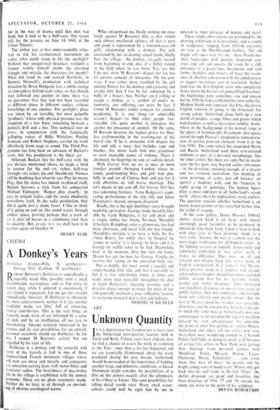Unknown Quantity
ART relation to their intricacy of texture and motif.
These simple observations are prompted by the glowing exhibition of watercolours, and a couple of sculptures, ranging from 1933-66 currently on view at the Marlborough Gallery. The old magic still takes over for me: those Pembroke- shire landscapes with densely shadowed con- tours and soft red sunsets, the roads by a cliff, entrances to a green lane. thornheads and root forms, boulders and insects, all have the reson- ance of absolute conviction with the added power to suggest mysterious acts of revelation. Suther- land was the first English artist who completely broke down the barriers of genteel English colour: the beginnings were sometimes raw and uneasy but by 1950 he had established his own authority. Mathew Smith only repeated. like Etty, the classic English solution of going to the Venetians for strong colour. Sutherland alone built up a new world of purples, orange, blues and greens which had dramatic as well as decorative validity. Some- where in the background of his formal range is the ghost of Grtinewald's Eisenheim altar-piece, sieved through Picasso's imaginative reinterpreta- tion of certain pain-sex elements from it in the late 1930s. The same source has nourished Matta and Bacon. Sutherland used these re-translated emblems as part of a personal morphology, like the other artists; but there are signs that in recent years he has gone way beyond earlier references —in the direction, curiously enough, of a clearer and less tortured naturalism. I'm thinking of some paintings of scales, just off balance, set against a shadowy wall, and the 'fountain at night' group of paintings. The human figure plays a most odd part in all Sutherland's recent work : always there by implication, rarely explicit. The question remains whether Sutherland is an exotic nature-painter or has travelled further into the realm of tragedy.
At the same gallery, Henry Moore's 1940-42 shelter sketch book is on show, with almost alarmingly good facsimiles to be produced in edition de luxe book form. I find it hard to look with clear eyes at these drawings made as a 'war artist,' because the war as a whole was the most tragic irrelevance for all English artists: in the fighting services or (equally dangerously and arduously) embroiled in 'war artists' work, it makes no difference. They were cut off and isolated and thrown back into minor paths of English romanticism. It is ironical that Moore, whose pre-war work as a sculptor had already achieved great heights, should have been accorded public acclaim first for his war-time family groups and shelter drawings. They enshrined and ennobled, of course, an uncon-cious wave of public feeling: here was endurance and fortitude made into concrete and specific images. But the best of Moore's work lies in other, less agreeable, directions. and the war put him back by a decade, in much the same way as Sutherland's post-war commitment to an interminable tapestry problem delayed his own advancement. To underline the point of what I'm getting at : whilst Moore, Sutherland and others (all our artists now over thirty-five) were wandering around in a Samuel Palmer half-light, or doing no work at all because of service life, artists in New York were getting their bearings from personal contact with Mondrian, Ernst, Masson, Breton, Leger, Duchamp, Matta, Tchelitchev . . . you name them, they were all there: the parents and the bright young sons of modern art. Moore only got back into his real stride in the late 'fifties: the shelter drawings are good and inventive, but three drawings of 1934, '37 and '39, outside the room, are more to the point of his sculpture.
BRYAN ROBERTSON


































 Previous page
Previous page